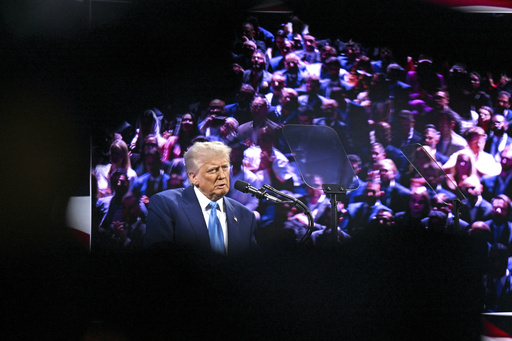WASHINGTON — Within a month of President Donald Trump’s second term, the legal team representing the Republican administration appears determined to instigate a judicial confrontation aimed at dismantling a nearly century-old Supreme Court ruling, known as Humphrey’s Executor, that has played a pivotal role in shaping the contemporary U.S. government structure.
The 1935 Supreme Court decision established a framework for independent federal agencies that oversee crucial aspects like labor relations, employment discrimination, and communication industries. The Court unanimously determined that presidents cannot dismiss appointed officials of these agencies without a justified cause. This ruling has been a point of contention for conservative legal scholars who believe the presidential powers outlined in the Constitution do not allow for such limitations imposed by Congress and supported by judicial review.
These scholars criticize the modern administrative system, arguing that every federal agency under the executive branch should be directly accountable to the president, including the authority to remove their leaders at his discretion. The current Supreme Court, which has a conservative lean and includes three justices appointed by Trump, has shown some alignment with these views at various times.
Understanding the background of Humphrey’s Executor requires some historical context. William Humphrey, a Republican from Washington who lived during the Civil War, was appointed to the Federal Trade Commission by President Calvin Coolidge and later reappointed by Herbert Hoover. However, when Franklin D. Roosevelt, who assumed office in 1933, took office, he wanted to replace Humphrey with someone who aligned with his New Deal agenda. After Humphrey declined to resign, Roosevelt terminated his position despite existing legal provisions that allowed removal only under conditions of inefficiency, negligence, or wrongdoing.
Following Humphrey’s death a year later, his estate sought compensation through a lawsuit. The Supreme Court unanimously ruled that the establishment of the Federal Trade Commission was legitimate and that Roosevelt’s actions were unlawful. The justices articulated a need for independence among agency leaders, emphasizing that those who serve “at the pleasure” of the president cannot maintain necessary independence in their duties.
Central to this discussion is whether government agencies can operate independently or if they are merely extensions of the president. According to law professor Noah Rosenblum from New York University, the Court’s ruling decisively favored the notion of independence, particularly during a period when authoritarian regimes were prevalent in places like Germany and the Soviet Union.
Conversely, defenders of the president’s sweeping authority to dismiss officials argue that such independence is merely an illusion and is not supported by the Constitution’s framework. They highlight Article 2’s stipulation that assigns executive powers to the president, asserting that he is responsible for ensuring the faithful execution of laws. Chad Squitieri, a law professor at Catholic University, contends that the Supreme Court’s 1935 ruling misinterpreted constitutional principles regarding independent agencies.
More recently, since 2010, the Supreme Court has adopted a critical stance regarding any federal restrictions on the presidential powers of removal. Chief Justice John Roberts, having initially worked in the Reagan administration which supported expansive presidential powers, indicated in a 2020 ruling that the president’s capacity to remove officials is the general rule, not the exception. This judgment upheld Trump’s dismissal of the Consumer Financial Protection Bureau’s head, though it did not directly overturn Humphrey’s Executor, leading some justices, including Clarence Thomas and Neil Gorsuch, to voice their desire to completely revisit the earlier decision.
Currently, the Supreme Court is deliberating on an emergency appeal from the administration concerning a lower-court order that temporarily bars Trump from dismissing Hampton Dellinger, the chief of the Office of Special Counsel.
In an apparent attempt to reshape the landscape, Trump terminated Gwynne Wilcox, the first Black woman on the National Labor Relations Board, shortly after taking office. Wilcox’s dismissal marked the first firing of an NLRB member in the board’s history since its establishment shortly after the Humphrey’s Executor verdict. She has launched a legal battle to reclaim her position, bringing forward a case that could challenge the ongoing relevance of the Humphrey’s Executor decision.
Moreover, Sarah Harris, a senior official in the Justice Department, communicated to Senator Dick Durbin that the Department now views federal laws safeguarding members of multisector commissions as unconstitutional. She specifically references several agencies, including the FTC and the NLRB, asserting that their current structures wield significant executive powers without being historically grounded.
Experts warn that if the Court decides to agree with the administration’s standpoint, numerous agencies tasked with consumer protection, labor rights, and nuclear regulation could be jeopardized. Brianne Gorod, chief counsel at the progressive Constitutional Accountability Center, noted that agencies might transform into instruments serving whoever occupies the presidency, potentially undermining democratic checks on power.
Interestingly, while the administration seems willing to challenge the independence of various regulatory bodies, they have treaded carefully when discussing the Federal Reserve’s autonomy concerning interest rate settings and monetary policy decisions. Nonetheless, legal experts recognize that the rationale against Humphrey’s Executor could easily extend to the Fed, unless the court specifically exempts it from such implications.
Squitieri suggests that a politically accountable Federal Reserve under presidential oversight may not be as alarming as it appears. He raises the point that society entrusts presidents with sensitive matters like nuclear codes, indicating a level of trust in their management of the Fed is warranted. Conversely, experts emphasize that the Fed has been perceived historically as neutral, cautioning against the risks of a politically influenced central banking system if presidential appointees begin to steer its operations.




